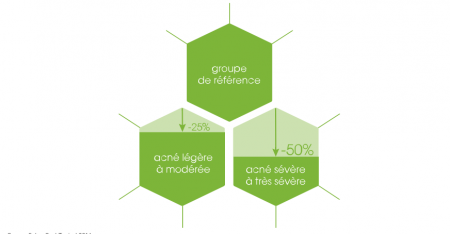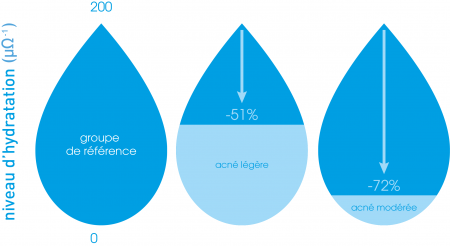What is dysseborrhoea? (and what is its role in acne?)
You undoubtedly know that acne is largely related to sebum quantity and mainly affects oily skin. There can be no acne without hyperseborrhoea, i.e. without excessive sebum production.

You undoubtedly know that acne is largely related to sebum quantity and mainly affects oily skin. There can be no acne without hyperseborrhoea, i.e. without excessive sebum production.
But while acne is clearly associated with excess sebum, other factors also come into play. Discovered just a few years ago by leading acne specialists, dysseborrhoea refers to changes in sebum quality specifically occurring in people with acne. This major discovery has changed the therapeutic approach to acne. What exactly is sebum, and what sebum composition problems can cause acne?

A substance naturally secreted by the human body, sebum is essentially made up of lipids from the sebaceous glands: triglycerides, wax esters, squalene (12%), cholesterol esters and fatty acids. Often combated due to its role in blemishes and unwanted shine, it is nonetheless essential to maintaining balanced skin. Sebum is a component of the skin’s hydrolipidic film. It is in charge of protecting the skin, maintaining its level of hydration, preserving the cutaneous microbiota, and limiting the development of pathogens. It thus needs to be preserved, even though efforts are sometimes required to regulate excess production...
A study* undertaken with 914 patients* showed:
Moreover, sebum reduction is correlated with improvements in acne lesions. A 30% to 50% decrease in sebum production is necessary to achieve a 50% decrease in acne lesions. Thus, there will be no acne without an increase in sebum quantity.
Acne-prone skin is characterised by poor-quality sebum, in particular with a lack of vitamin E, which protects the lipids in sebum from oxidation. Due to this lack of vitamin E, sebum composition in acne-prone skin is altered with the oxidation of squalene. This sebum is comedogenic and highly irritating. But that’s not all.
Vitamin E is a natural antioxidant found in sebum. And yet recent research demonstrated a correlation between low levels of vitamin E in blood plasma and the severity of blemishes.

Researchers have discovered that fatty acids prevent the skin from properly playing its barrier role and thus increase transepidermal water loss (TEWL). This means that acne-prone skin is naturally more dehydrated than healthy skin. The weakening of the barrier function maintains a state of inflammation and leaves the skin more susceptible to redness and irritation. The sensitivity of acne-prone skin can be even further aggravated by the use of harsh acne treatments, especially those with keratolytic action (adapalene, BPO, etc.).
